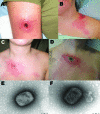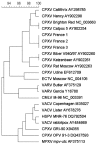Cowpox virus transmission from pet rats to humans, France
- PMID: 19402968
- PMCID: PMC2686997
- DOI: 10.3201/eid1505.090235
Cowpox virus transmission from pet rats to humans, France
Abstract
In early 2009, four human cases of cowpox virus cutaneous infection in northern France, resulting from direct contact with infected pet rats (Rattus norvegicus), were studied. Pet rats, originating from the same pet store, were shown to be infected by a unique virus strain. Infection was then transmitted to humans who purchased or had contact with pet rats.
Figures


References
-
- Moss B. Poxviridae: the viruses and their replication. In: Knipe DM, Howley PM, editors. Fields virology, 4th ed. Philadelphia: Lippincott Williams & Wilkins; 2001. p. 2849–83.
-
- Damon IK, Esposito JJ. Poxviruses that infect humans. In: Murray PR, Baron EJ, Jorgensen JH, et al., editors. Manual of clinical microbiology. Washington: American Society for Microbiology; 2003. p. 1583–91
-
- Laakkonen J, Kallio-Kokko H, Oktem MA, Blasdell K, Plyusnina A, Neimimaa J, et al. Serological survey for viral pathogens in Turkish rodents. J Wildl Dis. 2007;42:772–7. - PubMed
Publication types
MeSH terms
Associated data
- Actions
- Actions
- Actions
LinkOut - more resources
Full Text Sources
Other Literature Sources
Medical
